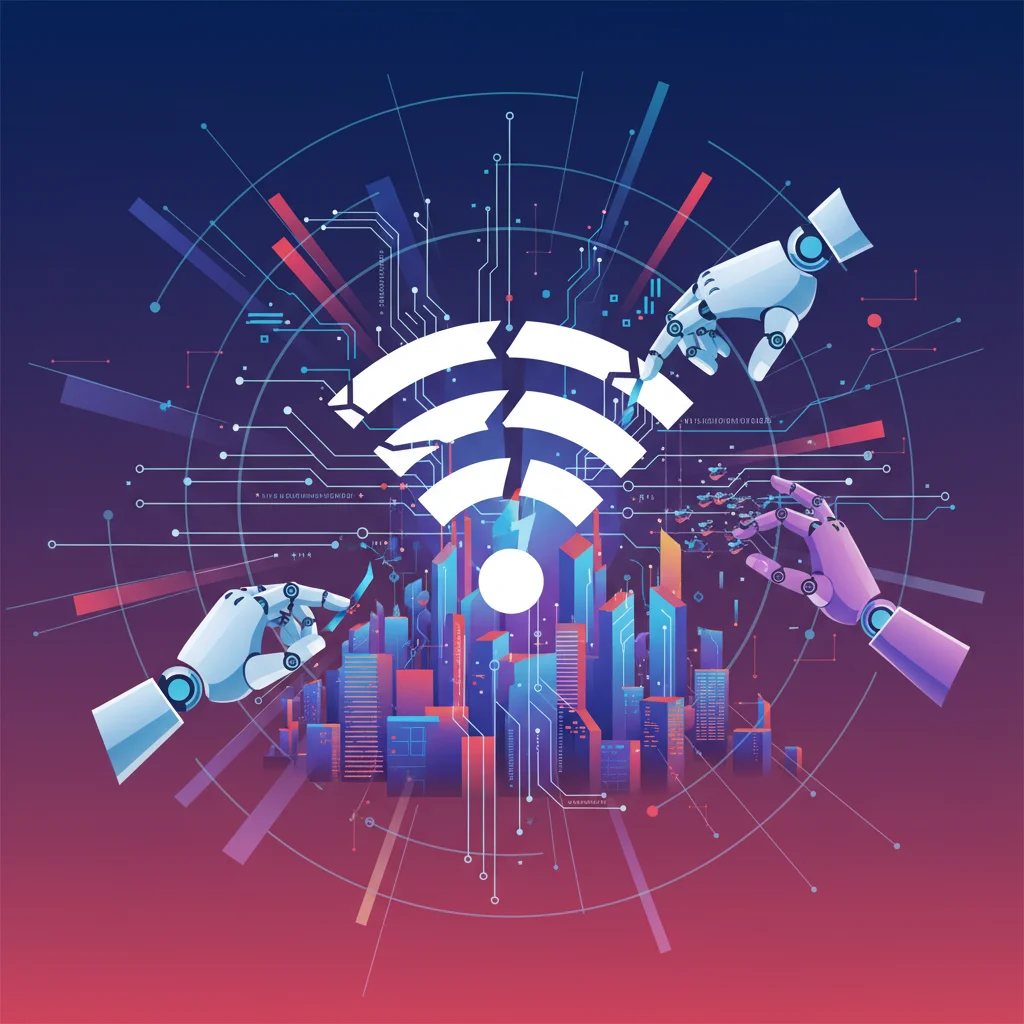
Vodafone’s Outage is a Wake-Up Call: Why AI and Automation Are the Future of Network Resilience
That familiar, sinking feeling. The Wi-Fi icon shows an exclamation mark. Your phone, despite showing full bars, can’t load a single webpage. You toggle Airplane Mode on and off, a modern-day rain dance, but the digital silence persists. For over 130,000 Vodafone customers recently, this wasn’t just a momentary glitch; it was a stark reminder of how fragile our connection to the digital world can be.
Vodafone, a titan in the UK with over 18 million customers, experienced a significant service disruption, highlighting a vulnerability that extends far beyond a single carrier. In an age where businesses are built on the cloud, startups live and die by their SaaS availability, and our daily lives are interwoven with constant connectivity, an outage is no longer a minor inconvenience. It’s a critical failure of infrastructure with cascading consequences.
This event isn’t just a story about a telecom company’s bad day. It’s a crucial case study for developers, entrepreneurs, and tech leaders. It forces us to ask a fundamental question: Is the technological foundation of our society, built on legacy systems and reactive problem-solving, robust enough for the future? The answer, increasingly, is no. The path forward lies not in simply patching old systems, but in a radical redesign centered around artificial intelligence, proactive automation, and intelligent software architecture.
The Anatomy of a Digital Blackout
When a service as massive as a national telecom network falters, the cause is rarely a single, simple mistake. It’s often a complex interplay of factors, a perfect storm brewing within layers of hardware, software, and human processes. For tech professionals and startup founders, understanding these potential points of failure is the first step toward building more resilient systems of their own.
Modern outages can generally be traced back to one of several culprits:
- Software and Configuration Errors: A seemingly innocent code push or a minor change in a network configuration file can have catastrophic, unforeseen consequences. These are the digital “fat-finger” mistakes, where a single wrong line of programming can bring services to a grinding halt.
- Hardware Failure: Physical infrastructure—servers, routers, fiber optic cables—degrades over time. While often redundant, a failure in a critical, non-redundant component or a cascading series of failures can trigger a widespread outage.
- Cybersecurity Incidents: Malicious actors are constantly probing for weaknesses. A Distributed Denial of Service (DDoS) attack can overwhelm a network with junk traffic, making it inaccessible to legitimate users. More sinister attacks can infiltrate and disable core systems directly.
- Third-Party Dependencies: The modern tech stack is a web of interconnected services. A startup’s application might rely on a cloud provider for hosting (like AWS or Azure), a SaaS platform for payments (like Stripe), and another for authentication (like Okta). A failure in any one of these upstream providers can create a downstream blackout for countless businesses. The 2021 AWS outage that took down everything from Disney+ to robot vacuums is a prime example.
To put this in perspective, here’s a breakdown of common outage causes and their characteristics:
| Outage Cause | Typical Trigger | Detection Difficulty | Resolution Strategy |
|---|---|---|---|
| Software/Configuration Error | New code deployment, system update, or manual change. | High (can be subtle and hard to trace). | Rollback changes, deploy a hotfix, automated config validation. |
| Hardware Failure | Aging equipment, physical damage, power loss. | Moderate (often triggers clear alerts). | Automated failover to redundant systems, physical replacement. |
| Cybersecurity Attack (e.g., DDoS) | Coordinated flood of malicious traffic. | Low (traffic spikes are obvious). | Traffic scrubbing, IP blocking, AI-based threat detection. |
| Third-Party Dependency Failure | An outage at a key cloud or SaaS provider. | Low (provider status pages are the first alert). | Multi-cloud/multi-vendor architecture, graceful degradation. |
The Cascade: When Downtime Costs More Than Time
The direct cost of an outage is lost revenue, but the indirect costs are often far greater. For the modern economy, connectivity is oxygen. When it’s cut off, every part of the ecosystem suffers.
For startups and entrepreneurs, an outage is an existential threat. A SaaS platform that is down is not just losing subscription revenue; it’s actively eroding customer trust. A B2B software company that can’t guarantee uptime will quickly lose out to more reliable competitors. For an e-commerce startup, every minute of downtime during a peak sales period can mean thousands in lost orders and potentially permanent customer churn.
For developers and tech professionals, an outage grinds productivity to a halt. In a world of remote work and distributed teams, a network failure means no access to cloud environments, no connection to code repositories like GitHub, and no way to collaborate on platforms like Slack or Teams. It’s a forced, frustrating coffee break for the entire engineering department.
The silent killer is the long-term damage to brand reputation. Reliability is a core feature of any digital product or service. A single, high-profile failure can undo years of marketing and brand-building efforts, creating a perception of instability that is difficult to shake.
The Proactive Paradigm: How AI and Automation Build Unbreakable Infrastructure
The traditional model of network management is reactive: an alarm bell rings, and a team of engineers scrambles to find and fix the problem. This model is no longer sufficient. The complexity and scale of modern systems demand a new, proactive paradigm powered by cutting-edge technology.
Artificial Intelligence and Machine Learning (AIOps)
AIOps is the application of artificial intelligence to automate and enhance IT operations. Instead of waiting for a system to break, machine learning models continuously analyze vast streams of telemetry data—network traffic, server CPU usage, application error logs—to predict failures before they happen.
- Predictive Maintenance: An AI can analyze performance metrics from thousands of network routers and predict that “Router 734” is 95% likely to fail in the next 72 hours due to abnormal temperature fluctuations. This allows engineers to replace it during a scheduled maintenance window, averting an outage entirely.
- Anomaly Detection: ML models learn what “normal” network behavior looks like. When they detect a deviation—a sudden, unusual surge in traffic from a specific region or a bizarre pattern of API calls—they can instantly flag it as a potential cybersecurity threat or a critical software bug, long before it impacts users.
Automation: The Self-Healing Network
Once an issue is detected, the goal is to resolve it without human intervention. This is where automation comes in. Intelligent automation platforms can execute pre-defined playbooks to remediate issues in seconds.
- Automated Failover: If a primary database server becomes unresponsive, an automation script can seamlessly re-route all traffic to a backup server in a different geographic location in milliseconds. Users experience no disruption.
- Automated Remediation: If AIOps detects that a bad software deployment has caused a spike in application errors, an automation system can instantly trigger a rollback to the previous stable version, fixing the problem before the support team even receives the first ticket.
Cloud Architecture and Secure Programming
Resilience also starts at the design phase. For startups building on the cloud, this means architecting for failure. This involves using multiple availability zones or even multiple cloud providers to eliminate single points of failure. If one data center goes down, your service continues to run from another.
This philosophy extends to the programming itself. Writing secure, robust software is a core tenet of reliability. Developers must embrace practices like “chaos engineering,” a concept pioneered by Netflix where you intentionally inject failures into your own systems to find weaknesses before they become real-world problems. According to a report on the cost of downtime, 91% of enterprises report that a single hour of downtime for mission-critical systems can cost over $300,000. This highlights the immense ROI of investing in resilient architecture and practices.
Your Resilience Checklist: Actionable Steps for a More Stable Future
Whether you’re a founder, a developer, or a business leader, you can take concrete steps to protect your operations from the fallout of the next big outage.
Here is a quick-glance checklist for building resilience:
| Audience | Key Action Items |
|---|---|
| Startups & Entrepreneurs |
|
| Developers & Tech Professionals |
|
Conclusion: From Reactive Firefighting to Intelligent Prevention
The Vodafone outage, while disruptive for thousands, serves as a powerful catalyst for a much-needed conversation about our digital infrastructure. It’s a clear signal that the old ways of managing complex, interconnected systems are breaking under their own weight. Relying on human-led, reactive problem-solving in an era of automation and AI is like trying to navigate a superhighway with a horse and cart.
The future of connectivity—and by extension, the future of business, innovation, and modern life—depends on our ability to build smarter, more resilient systems. This is a monumental challenge, but also an incredible opportunity. The next wave of technological innovation won’t just be about creating new services; it will be about ensuring the ones we already depend on are always on, always secure, and always reliable, powered by the proactive intelligence of AI and automation.


